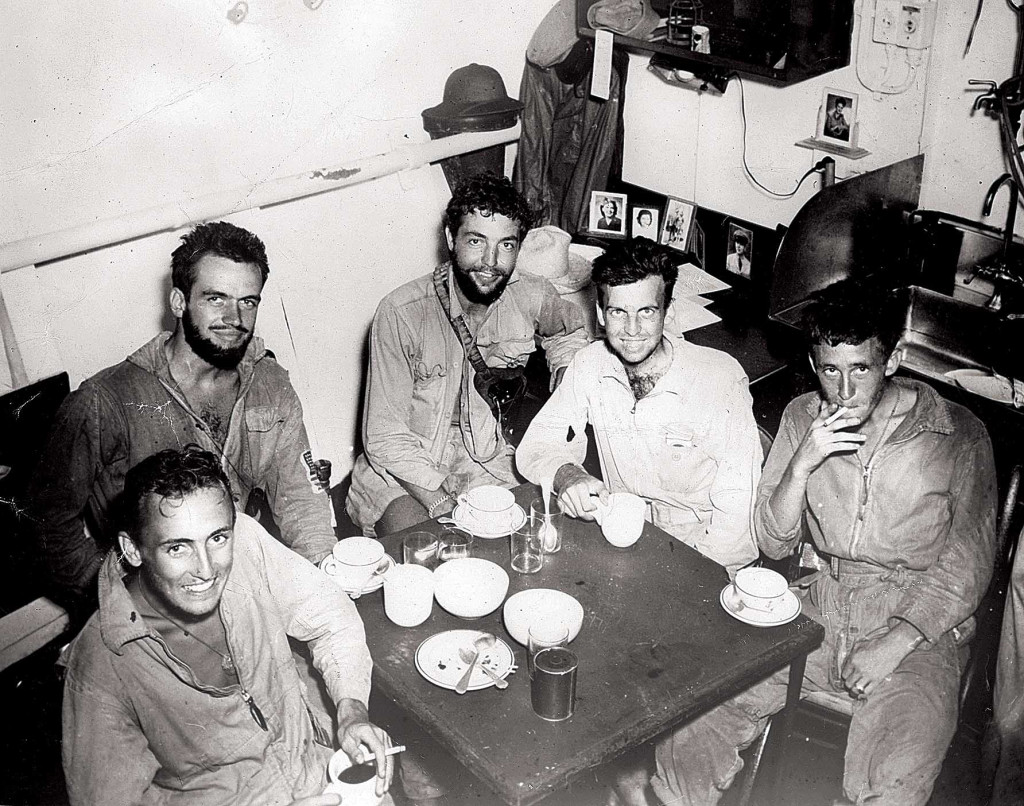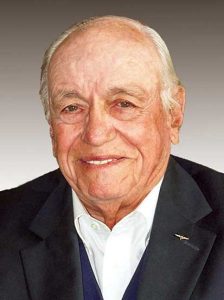A story of survival and luck during World War II in the South China Sea.
Enlarge

U.S. Navy photo, 80-G-320999
By David L. Bristow, History Nebraska
U.S. Navy Ensign John Doyle’s chances of surviving World War II seemed bleak on Nov. 25, 1944, as he struggled to hold his burning dive bomber on target over the South China Sea,” writes Samuel Van Pelt. “While attacking a Japanese heavy cruiser, anti-aircraft fire damaged his plane, but Doyle still managed to release his bomb and score a hit on the ship.”
Back home in Lincoln, Nebraska, Doyle’s parents, Lewis (“Lum”) and Mary, received a telegram saying their 20-year-old son, also known as Dugie, was missing in action. Later, they received a letter from Captain Dixie Kiefer, commander of Dugie’s aircraft carrier, the USS Ticonderoga. By coincidence, the captain was an old friend of Lum’s. He wrote:
“It was the most heroic case I have seen on this trip and was over and above the call of duty. His plane caught fire at 9,000 feet from anti-aircraft. Instead of getting over friendly natives and using the parachute, knowing that the cruiser was the biggest type and a very important target, he went on down and scored a direct hit, crippling it so others could sink it. He has been recommended and will receive the Navy Cross. He then landed in the water and was seen by the rest to get clear and in a rubber boat.”

By then, a month had passed, and Dugie was still missing. He had gone down off the Philippine island of Luzon, but it was occupied by the Japanese.
In 1993, Dugie Doyle — still very much alive — told his story to fellow Lincoln attorney Sam Van Pelt. Doyle explained that after he and his crewman took to their raft, they floated for more than a day waiting for a rescue sub. Then, “all of a sudden, I never saw this Japanese plane coming. He was right on top of us.” Doyle and his crewman flipped the raft over while the Japanese plane flew so close that Doyle could see the observer’s goggles.
After that, they figured they had better take their chances on shore. A Filipino man guided them to a small village of bamboo huts, where local people fed them. But “the word got out that Americans were up in the hills … We got the hell out of there just in time.”
A local guerilla leader led them to the hideout of Lt. Colonel Giles Merrill, who had escaped the Bataan death march in 1942 and had been living in the jungle since. Rail-thin from malaria and dysentery, Merrill “was a character and would strap on his pith helmet and his .45” while working with local Filipinos to protect any Allies who came his way. He kept up with the latest news in a hut that was “a regular war room” with a card table, road maps and a bicycle-powered shortwave radio receiver.

Merrill knew that three downed American flyers were hiding out in an isolated bay 7 miles distant. Doyle and his crewman went to join them. Doyle urged Merrill to come along. At the bay, Doyle argued, they would stand a better chance of rescue. But Merrill remained at his remote command post to await the promised return of General Douglas MacArthur to the Philippines.
At the bay, Doyle and the others signaled passing U.S. planes. “When they came over, we would catch them with the mirror and get their attention. Then we would write stuff in great big letters in the sand, like ‘food,’ ‘fever’ and the code word for a rescue plane in the navy, ‘Dumbo.’” One day, an army A-20 zoomed the beach but didn’t make it up over the hills.
“He stalled out and crashed. Oh God, the plane’s ammunition was going off for about three hours.” The next day, Jan. 10, 1945, two of the men on the beach climbed the hill to bury the plane’s crew. It was then that a Navy PBY “Catalina” flying boat landed in the bay.
“They must’ve set the world’s dash record coming down that hill. The natives then rowed us in a wooden bark or hollowed log canoe out to the PBY, and we all got aboard.”

Doyle and the others were soon back with the U.S. fleet off the eastern shore of Leyte, where three of the five men were pronounced fit to “rejoin their outfits or go home.”
But Doyle was sick with malaria. He argued with the doctor, but was not allowed to board the transport plane with
the others.
The transport crashed soon after takeoff, killing all on board.

“I would have been on that plane if I hadn’t had malaria or had won that argument with the doctor … It was from an Anopheles mosquito, and it saved my life.”
Back home in Lincoln, Doyle went on to a distinguished career as an attorney and as president of the Lincoln Council on Alcoholism and chairman of the National Council on Alcoholism. When he died in 2013, he was known more for “his life serving others” (in the words of a Lincoln Journal Star headline) than for his Navy Cross.
Abiding by Doyle’s wishes, Van Pelt withheld the 1993 interview from publication during Doyle’s lifetime. Nebraska History Magazine printed the full interview in 2014.
Visit History Nebraska’s website at history.nebraska.gov.
The post Shot Down in World War II appeared first on Nebraskaland Magazine.
















